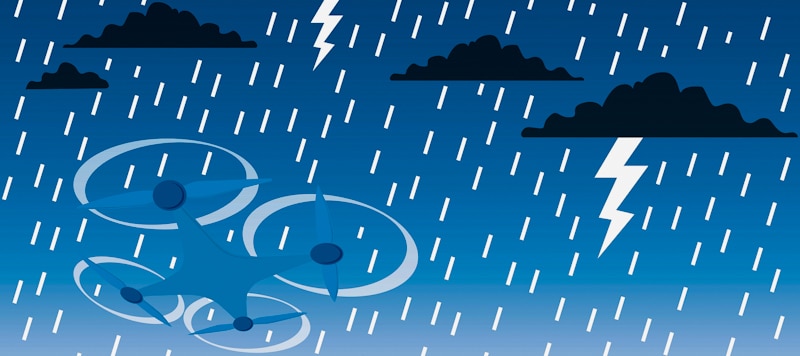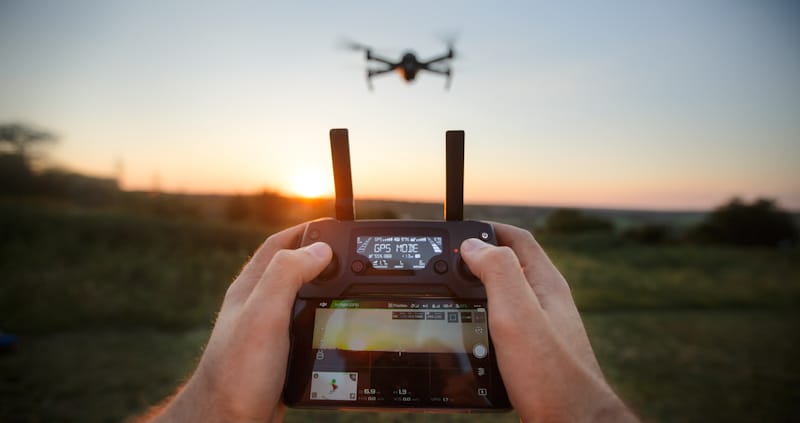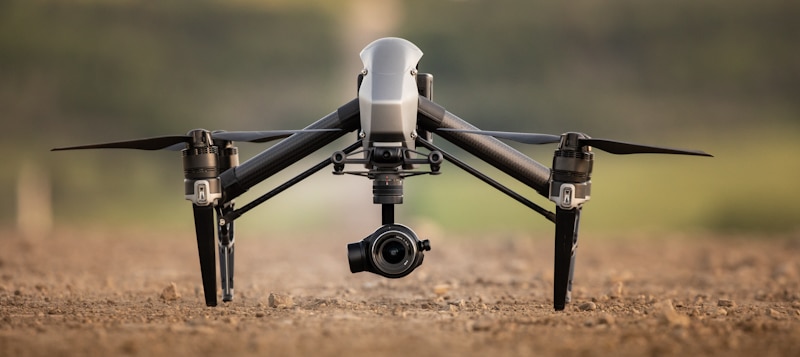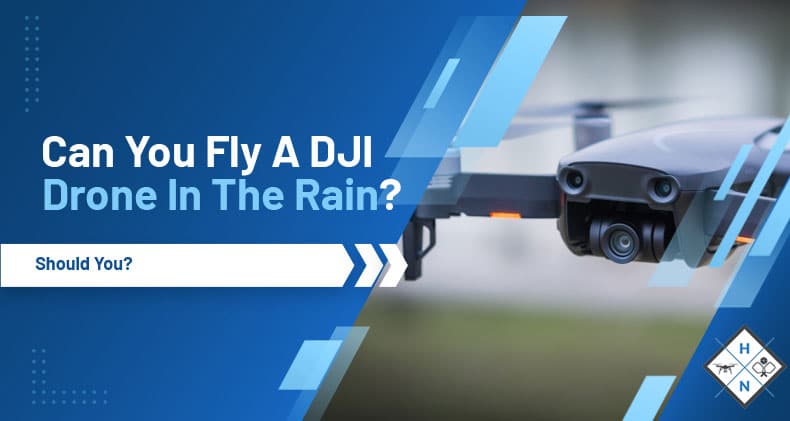When you get a new drone you'll find yourself wanting to play with it a lot. You may not even think about how the weather is outside you just want to see how your new drone works. However, considering that drones are little electrical machines this is something you must take into consideration.
Unfortunately, since DJI drones aren't waterproof, water-resistant, or floatable you can't fly them in the rain. However, very light rain is fine. You can also apply a very thin protective layer of water repellent to them which would then enable you to fly them in the rain.

Understanding Waterproof vs Water Resistant
It's important to understand that there's a huge difference between something being "waterproof" and "water-resistant."
When electronics are said to be "water-resistant" it means that they can briefly come into contact with water but they can't be submerged. In other words, you can spill or splash water on them as long as you don't dunk it in the water. So, if you have a water-resistant drone it can handle a little rain but you're better off not getting it wet.
On the other hand, "waterproof" electronics are those that can be submerged underwater – usually up to a certain depth for a certain amount of time. This will give you a lot more freedom if you want to get your drone wet because it should be fine even if you drop it in the water. It's still a good idea to use caution here though because regardless of how "waterproof" something claims to be its electrical components can still be damaged. Usually, these components aren't covered by a warranty so if you're faced with a hefty repair bill you may be the one who has to pay for it.
DJI Drones in Rain, Fog, and Humidity
There are a lot of different types of precipitation that you may encounter with your drone. Each of these will impact your drone in a different way so it's a good idea to take some time to think about each of them.
Drones in Rain
It's possible that there may come a time when you, unfortunately, find yourself flying your drone in the rain. When this happens you may be concerned about what will happen to your drone. This isn't something that DJI condones but this doesn't stop people's curiosity. You should also know that what happens to one person's drone when it gets wet won't necessarily be the same thing that happens to your drone. This is because you have to take into consideration things like how much water there was and if it was windy.
You should also know that even if a drone looks fine after it's been flown in the rain, corrosion takes days, if not weeks, to settle in. This means that your drone may have weathered some rain and been seemingly fine it may not be fine in a few days or weeks. It also means that another person could fly their drone in the same conditions and their drone would suffer from immediate damage.
Another thing you should also consider is your reasoning for flying your drone in the rain. If you're doing so in an attempt to get photographs you should know that as soon as a drop of water hits your camera's lens you won't be able to get any clarity from it.
Additionally, you don't want to be flying your drone when there's lightning because your drone could possibly be struck by it. This becomes slightly riskier due to the fact that lightning carries a high magnetic field. Unfortunately, if your drone does get struck by lightning you should know that the after-sales service policies clearly state that your drone won't be covered by DJI's limited warranty.
Drones in Humidity
While you may think that the only issue with humidity would be that your drone has been exposed to moisture for a prolonged period of time but humidity can also interfere with its radio signal. This is because humidity affects how permeable the atmosphere is. However, there aren't any reports that have directly linked a drone's weak signal to humidity. Instead, this is expected to become more of a factor at long ranges.
Drones in Fog
While fog won't present the same immediate threat as rain, you still don't want to be out flying your drone in it. Not only will fog create a thin layer of moisture on your drone but it'll also decrease visibility. This is an important consideration because the FAA (Federal Aviation Administration) says that you can't fly your drone beyond your visual line of sight.

Tips for Flying in the Rain
Sometimes you simply can't help that it's started raining. However, as a drone pilot, you should always keep an eye on the sky. When there's even the slightest chance for rain in the forecast you should fly your drone close to your location. If it does happen to start raining you should attempt to fly your drone home backward because then water is less likely to get sucked up through your drone's intake.
Once you retrieve your drone you should immediately turn it off and take out its battery. This will give you an opportunity to see how wet your drone is so you'll be able to determine what the best course of action will be. If your drone got caught up in a light drizzle you can simply leave your drone somewhere dry with its battery removed for a while. However, if your drone got drenched you'll probably need to throw the battery in the trash so you don't risk any more damage to your drone. In either case, make sure you let your drone sit for a few days before you turn it on gain. You should also remember that if you open your drone in an attempt to dry it inside you'll void its warranty.
Damage Caused by Rain
There are a lot of different components inside your drone that could be damaged if you fly it in the rain. If you have a camera mounted on your drone it's possible for the rain to penetrate through this area. Although the spinning props are somewhat shielded by their spinning props they're still somewhat exposed. This means that one of your drone's electronic speed controllers (ESC) could short-circuit causing your drone to instantly fall from the sky.
Even if your drone doesn't fall from the sky and it returns safely to you without any apparent water damage you may still have issues. This is because when electronics sit in water for an extended period of time usually have issues.
Once it's finally stopped raining and it's safe to fly your drone again you'll want to make sure that it doesn't take off near a puddle – regardless of how small it may be. Unfortunately, your drone may still suck up some dirty water into its intake. This is just as bad as if you'd flown through the rainstorm. This is why you should use a launchpad when you're taking off near water, sand, or dirt.
Waterproof DJI Drones
Living someplace where it always seems to be raining out doesn't mean you won't ever get to enjoy flying your drone. Fortunately, there are a few options you can choose from here.
One of the best options you have available here is to invest in a water-resistant drone. The Matrice 200 series by DJI has received an ingress protection (IP) level of IP43. To understand what this means you must first understand that an IP rating has to do with how much protection the drone's electrical enclosures have against solids and liquids. Since the Matrice 200 series has an IP43 it means that any small wires over 1 millimeter are protected from a water spray that's less than 60 degrees from vertical.
While the drone itself is water-resistant the camera itself is not. However, since the camera is located underneath the drone it'll probably be fine as long as the drone isn't moving too fast. This is why Matrice 210 pilots have reported that they've been able to fly their drones in the rain without their cameras experiencing any adverse effects.
It's important to understand that when DJI says the Matrice 200 series is water-resistant what they're saying is that it's splash-proof. This is why you should still land it quickly if it starts to rain and never purposely fly it through a rainstorm. In the event that you do find yourself caught in a rainstorm, it's a good idea to fly your drone back home as quickly as possible, land immediately, and leave your drone to sit out overnight at room temperature to dry. If you take these precautions, you shouldn't have any issues.
The Matrice 200 series is great for anyone who needs their drones to have industrial capabilities. This is why hobbyists or people who are on a strict budget should consider another option that's offered by Phantom Rain. This company has actually made wetsuits that are compatible with their Phantom 4 drones. These wetsuits have created a seal around the drone's gimbal, battery, props, and SD card. While you still won't be able to take any clear pictures if your drone's lens gets wet at least you can still operate your drone. This is why the Phantom Rain series has proven itself to be a great search and rescue (SAR) drone. The U.S. Coast Guard has actually discovered that it's useful in a lot of their SAR missions.

DJI’s Warranty and Water Damage
When you take a minute to read through what DJI covers in their limited warranty you'll find it clearly stated that "Damage caused by operation in bad weather (i.e. strong winds, rain, sand/dust storms, etc.)" is not covered. However, you can purchase DJI Care Refresh. This is a comprehensive protection plan that covers your drone in case of accidental damage. With this coverage in place, DJI says that "Damage occurring after the product has come into contact with water is covered by the DJI Care Refresh. The product that suffers water damage can be replaced under DJI Care Refresh." So, if you plan to get your drone wet you'll want to make sure you have this coverage so you'll enjoy greater peace of mind.
Conclusion
It's never a good idea to fly your drone when it's raining outside. You never know how this wet weather could affect your drone. However, if you do get caught in the rain you shouldn't panic because most likely your drone will be fine.
Learn More: DJI Mini 2: Most Accessible Drone Out Right Now
Shawn Manaher loves to play with new toys and dive into new hobbies. As a serial entrepreneur, work definitely comes first but there is always room for hobbies.

